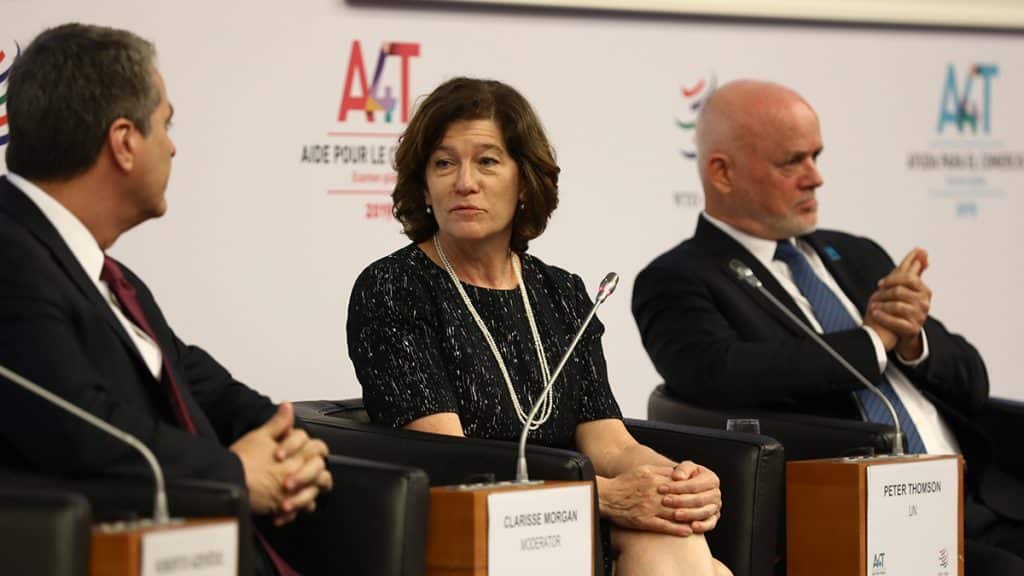La diversificación económica y el empoderamiento de las mujeres son fundamentales para subsanar las diferencias de desarrollo

La diversificación económica y el empoderamiento de las mujeres son claves para lograr un entorno comercial más justo y eficiente, según lo expresado por los oradores que intervinieron en varias sesiones del Examen Global de la Ayuda para el Comercio el 3 y el 4 de julio. La economía mundial ofrece muchas oportunidades para que las empresas crezcan, pero aún queda mucho por hacer en sectores como las subvenciones a la pesca a fin de preservar los recursos y lograr que los beneficios del comercio lleguen a más personas, acordaron los panelistas.
More must be done to ensure that the global economy better meets the needs of underserved stakeholders, including vulnerable countries, women traders and the youth, speakers said on Day 2 of the Aid for Trade Global Review. The plenary session started off the day with a discussion on how a WTO fisheries subsidies agreement is important for safeguarding and diversifying economic resources for coastal communities and for future generations.
«Global fish stocks are being depleted. According to the FAO (Food and Agriculture Organization), 33% of global stocks are overfished, and most of the rest are at their limits. This should be of concern to us all,» WTO Director-General Roberto Azevêdo said at the plenary. «Depleted stocks mean depleted economic activity for coastal communities, and millions around the world will lose their livelihoods. There is an urgent need to ensure sustainable use of oceans resources for future generations.»
WTO members can make an important contribution by successfully concluding negotiations for new global rules that will curb harmful fisheries subsidies, DG Azevêdo added, emphasizing the end-2019 deadline for an agreement. Negotiators are currently under intense pressure amid the complex issues linked to fisheries management and sustainable development, he said, and complexities will surely re-emerge after new subsidy rules are finally agreed as members grapple with enforcement challenges.
«This is an important occasion to take stock of the fisheries assistance already being provided bilaterally and through international institutions and to consider what else would be needed to help with implementation of new rules,» DG Azevêdo said. «Of course, a new WTO agreement on fisheries subsidies by itself cannot address the whole spectrum of problems related to long-term fisheries sustainability but we can make an important contribution. So, let’s be ambitious with that contribution,» he said. See the full text of his speech here.
United Nations Special Envoy for the Oceans, Peter Thomson, likewise underlined the urgency of delivering a WTO fisheries subsidies agreement. New rules are essential to have healthy fisheries, which in turn are essential for a sustainable «blue» economy, he said.
A panel of speakers went on to discuss the needs of developing and least-developed countries and the technical assistance that can be made available to enhance the implementation of a future WTO agreement on fisheries subsidies. Representatives from Myanmar, Liberia and Samoa gave their perspective on the challenges their countries face in combatting harmful fishing practices and the special and differential treatment they desire in the ongoing negotiations.
Economic diversification: regional focus
The need to support economic diversification and empowerment was addressed in four separate thematic sessions from different regional perspectives: Africa, Asia and Pacific, Latin America and the Caribbean, and the Islamic Development Bank.
Panelists discussed the foreseen impact of the new African Continental Free Trade Area (AfCFTA) agreement, which entered into force on 30 May after the 22nd ratification was deposited with the African Union, and its potential to facilitate economic diversification and empowerment. Stephen Karingi of the UN Economic Commission for Africa said the new AfCFTA could increase inter-African trade by 15-25%, with two-thirds of gains in industrial goods trade. This latter figure is important for African countries seeking to reduce their dependence on raw commodities and provides a good incentive for policies promoting industrialization and diversification, he said.
At the Asia and Pacific focus session, the Asian Development Bank (ADB) launched the Aid for Trade report for Asia and Pacific 2019. The report highlighted the remarkable progress of the Asia and Pacific region and the structural transformations it went through, particularly the shift from the subsistence agriculture to manufacturing and services. The report acknowledged the significant role of international trade and foreign direct investment in this economic diversification and development. The report further flagged that more needs to be done to share the gains from trade equitably, and to create a level playing field for small businesses and women entrepreneurs. Samoa, Nepal and Cambodia shared their experience of how Aid for Trade helped them address the challenges they face, as a result of natural disasters and climate change, through enhancing these countries’ connectivity, infrastructure and supply side capacity.
The session organized by the Islamic Development Bank (IDB), an active contributor to the Aid for Trade initiative since its inception in 2006, highlighted the correlation between trade development, sustainable growth and global value chains. Citing South Korea as a success story in transitioning from a model based on commodities exports to manufacturing goods exports, Mohammed Faiz Shau Hamid of the IDB underscored the need to identify industry competitive advantages, increase participation in global value chains and maximize added value in sectors such as tourism. Despite progress, panelists highlighted the multiple common challenges faced by LDCs: meeting standard requirements in destination markets; competitiveness of locally manufactured products; institutional and legal constraints; and high energy costs which are hindering the capacity of poor countries to increase their participation in global trade.
The latter was discussed from a Latin American and Caribbean (LAC) perspective. Diego Aulestia, Ecuador’s Ambassador to the WTO, stressed that the region remains behind in terms of trade despite its potential, representing only 5.5% of global trade in goods and less than 3% of trade in services. The challenge is to determine what we want to sell and how we want to increase our share in global trade, he said. This session reviewed the progress of LAC countries, and how in a challenging global environment it has taken advantage of the tools of the WTO’s Trade Facilitation Agreement, such as the Foreign Trade Single Windows (VUCE), Authorized Economic Operator (AEO) programmes and Coordinated Border Management to improve its trade performance. Melvin Enrique Redondo, Secretary General of the Secretariat for Central American Economic Integration (SIECA), cited as an example the success of Central American customs integration, which has slashed trans-border crossing times from 40 to six minutes in recent years.
Trade facilitation was also identified as a driver for diversification at a session organized by Trademark East Africa (TMEA), which showcased the Regional Electronic Cargo Tracking Systems (RECTS) along the Northern Corridor (NC), the busiest and most important transport route in East and Central Africa, providing a gateway through Kenya to the landlocked economies of Uganda, Rwanda, Burundi and Eastern DR Congo, as well as South Sudan. The system has helped reduce the time and cost of trade from 18-21 days to 6-8 days to transit cargo from the port of Mombasa to Kigali and from 16-18 days from Mombasa to Kampala. It has also increased revenue to governments through reduced diversion in transit and enhanced risk management practices through border controls as well as allowing the private sector to keep real time monitoring of its transit cargo.
The session engaged with women traders from the East African Community (EAC) region to see how, in line with Canada’s Feminist International Assistance Policy, TMEA implements activities that aim to improve women’s representation in decision making and influence policies and regulations for a safe and gender responsive trading environment.
Empowerment of women
Speaking at a session on «Women entrepreneurs: Making the Buenos Aires declaration happen» on Day 1, DG Azevêdo focused on the empowerment of women as a means to ensure their full participation in global trade. The session took stock of progress and national experiences since December 2017 when over 100 WTO members signed the Declaration on Trade and Women’s Economic Empowerment at the 11th Ministerial Conference in Buenos Aires.
«If we want to seize all the opportunities that the global economy has to offer, we have to make sure that women are fully integrated into those efforts. Women entrepreneurs already play a vital part in many economies. According to some estimates, a third of all small and medium enterprises in developing countries are led by women,» DG Azevêdo said. «However, many barriers persist to their full participation in the global economy whether it’s fewer legal rights or political underrepresentation.» Read his full speech here.
Eliminating these barriers can have a tremendous social and economic impact. A McKinsey study estimates that closing the gender gap could add at least USD 12 trillion to global GDP by 2025. This is equivalent to the current GDP of Japan, Germany and the United Kingdom combined.
For Ann Linde, Minister for Foreign Trade of Sweden, it is encouraging that the trade and gender issue is increasingly on top of the agenda but there remains a long way to go. The first step could be systematically collecting gender-disaggregated data to better inform governments in formulating gender-equal trade rules.















